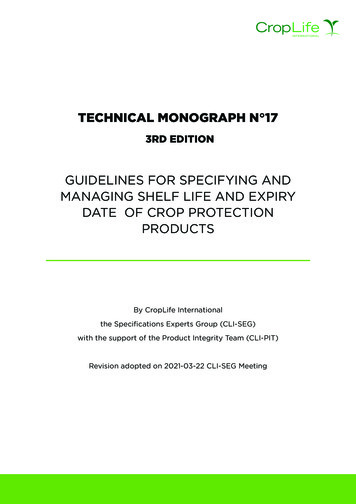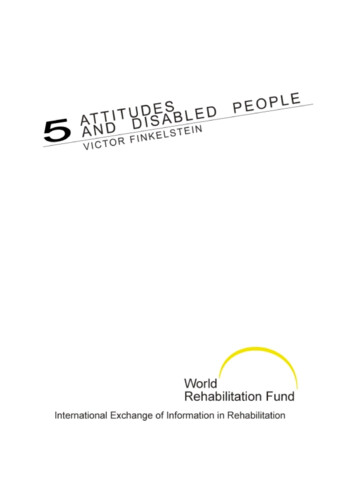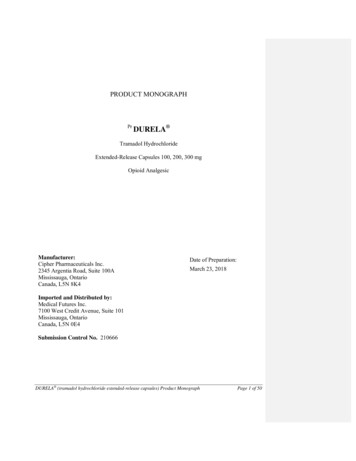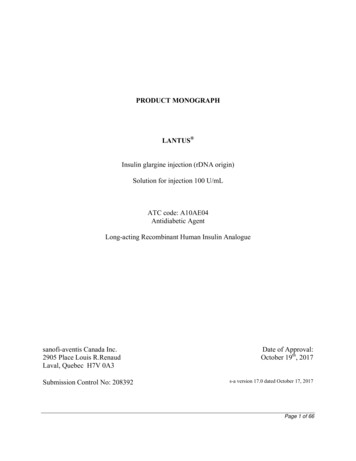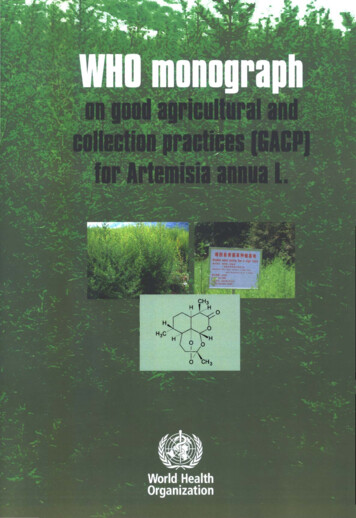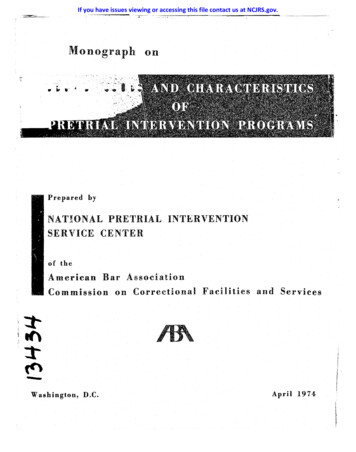
Transcription
If you have issues viewing or accessing this file contact us at NCJRS.gov.- --" ------,-----.------.-------Monograph, onPrepared hyNAT!ONAL PRETRIA.L INTERVENTIONSERVICE CENTERof theAmerican Bar AssociationCommission on Correctional Facilities and ServicesIB\j I1l1Washington, D.C.April 1974j
NATIONAL PRETRIAL INTERVENTION SERVICE CENTERMH" ii1I"IIIADVISORY BOARDSTAFFBertram S. Brown, ChairmanRockville, MarylandDUane BaltzWashington, D. C.James H. D'CMsWashington, D. C.William R. DrakeWashington, D. C.Larry L. DyeAmherst, MassachusettsWilliam B. HenschelMinneapolis, MinnesotaJoseph C. HowardBaltimore, MarylandRobert JohnsonAnoka, MinnesotaLeon G. LeibergCollege Park, MarylandRobert' F. LeonardFlint, MichiganManuel V. LopezSan Antonio, TexasSam P. McKenzieA tlanta, GeorgiaJoan MullenCambridge, MassachusettsSheldon PortmanSan Jose, CaliforniaHoward RosenWashington, D. C.Ted RubinDenver, ColoradoGeorge M. ScottSt. Paul, MinnesotaIrving R, SegalPhiladelphia, PennsylvaniaArnold J. HopkinsDirectorFrank J. JasmineAssistant DirectorMichael R. BielAssistant DirectorEvette HinkleAdministrative AssistantCen ter Liaison ICo-SponsorPMrick F. HealyExecutive DirectorNational District AttorneysAssociationChicago, II/inoi!" iI
Monograph on.;".-'.,II'.,.A., , - ;.,- ., .,I· .-. I . .,.- . -L.Prepared by Michael R. BielNATIONAL PRETRIAL INTERVENTIONSERVICE CENTERof theAmerican Bar AssociationCommission on Correctional Facilities and ServicesIH\i rjj!Washington, D.C.April 1974
- --'-,:. .:'C'Y1II.LEGAL ISSUES AND CHARACTERISTICS OFPRE'IRIAL INTERVENTION PRCGRAM3Table of ContentsPAGEFORFl\URDI.II.III.INTRODUCTION'iWHAT ARE 'lHE MAJOR lEGAL ISSUES AND CONSIDERATIONSASSOCIATED WIlli PRETRIAL INTERVENTION' PRCX;RAMS?'1MUST AN ACCUSED vru:vE HIS RIGHT 'ID A SPEEDY TRIALAND WE APPLICABlE STATU'IE OF LIMITATIONS 'ID QUALIFYFOR PARTICIPATION IN A Prux;RPM?5WHAT ARE 'lEE RESPECTIVE ROlES OF PROSECUl'OR ANDCOURT IN PRETRIAL INI'ERVENTION PRCGRAM3?13HAY ENTRANCE IN'IO A PRETRIAL JNTERVENTION PR(X;RAMAND ADHERENCE 'ID ITS REQUIREt1ENTS BE A XlIDITION OFRELEASE ON BAll.?24V.CAN A VIOLATION OF PR.(X;RAM GUIDELINES RESULT IN PRETRIAL (JAIL) CONFINEMENT?28VI.CAN ESTABLISHMENT AND AIl1INISTRATION OF ELIGmILITYCRITEfITA ABRIDGE CONSTI'IUTIONAL RIGHTS OF DUE PROCESSAND EQUAL PROI'ECTICN OF 'lEE lAWS?31CAN A POTENTIAL PRETRIAL JNTERVENTION PARTICIPANI' BE'ID PLEAD GUILTY IN ORDER TO BE Alt 1ITTED 'ID A44N.VII:REQUIRED.PROORAM?VIII.IX.MUST '!HERE BE A HEARING BEFORE A PARTICIPANI' IS'lERMINA.TED AS UNSUCCESSFUL AND RETURNED FOR RESUMPTICNOF PROOECUTION?53RElATED· ISSUES61RequirmgRestitution as a Condition of ProgramEligibili ty .'!he Ability· to Maintain Confidentiality in Comnn.mications Between Participants and ProgramStaff.Barriers to Utilization of Ex-Offenders onProgram Staff.Divulgence of a Perscn's Record of Participation:in a -Pretrial Intervention Program.61636567
1. 'FOREmID'Ihl.s IOOnograph represents one of several teclmical assistance proj ects of the National Pretrial Intervention Service Center tmdertaken inresponse to the tedmology transfer function assigned to ;'.t by the U. S.DepartlIElt of Labor tmder ManpCMer Grant No. 21-11-73-32. VJhat itattempts to do is offer the lay person a legal perspective as to thescope, authorization, procedures and constitutional issues of pretrialinterventi(ID program:;.Progr,am; of pretrial intervention represent a tmique approach tocriminal justice refonn whereby rehabilitation and treat:rrEnt opporttmitiesare made available to selected defendants in lieu of criminal prosecution.In this context, the "early diversion" concept was first tried in themid 1960' s and has since gravn dramatically through a succession ofderoonstration programs. Yet, we find little attention given the consequences of'by-passing the criminal trial process to allow for theintervention, sequence and its reginen of cOIIIIllJl1ity correctional services.The Center, therefore, deerred it t:i.m ly and a matter of professionalresponsibility to examine the practice in terms of the legal implicationsof pretrial intervention alternatives.Developing roost of this mmograph on a1 Issues and Cllaracteristicsof Pretrial Intervention Programs was an ar us and Challenging tmdertaking. Although there is an absence of definitive case law on the pretrial intervention tedmique, there exists a significant body of legaldoctrine on cr:i.minal pre-trial issues and events, which has analyticalrelevance to diversionary placerrent procedures. These are discussed inthe first four legal issues. Since we discovered that few projects havepolicy guidelines for operational procedures, the next four legal issuespresented discuss e inplicaticns of entry and exit decisions in pretrialintervention. The concluding section of the monograph is devoted tosituations we fotmd to be of concern to ac1mi.nistrators and planners ofpretrial intervention programs with whom Center staff has maintained acont:inuing dialogue. Thus, we feel that the m::mograph breaks new grotmdand will pranpt continuing cross currents of dialogue on the subject ofpretrial intervention legal issues aroong the diverse commmities interestedin this refonn treasure.A word of caution to readers. None of the legal issues addressedare considered dispositive of the several constitutional law questionsbearing on the early :intervention concept. Certainly, the absence of caselaw on the subj ect serves to put such a thought to rest. Vhat wasattempted here is the isolation, definition and analysis of those legalis§1.leS thought to have relevance in the p1.armi.ng and execution of pretrialintervention program:; . The mmograph should be regarded as a preliminaryanalysis. We envisage supplemmts or revisions to the m:mograph topennit further synthesis and explication as legal doctr:ine and experiencf?with the teclmique develops.Special recognition goes to Michael R. Biel, Esq., the principalauthor of this m::mograph, which he developed :in his capacity as AssistantDirector of the National Pretrial Intervention Service Center. For theirsage advice and legal analysis of the resultant work product, our deepi11 ,[f.
1appreciation is extended to:Ms. Leslie S. Burt, Esq.Special Assistant to the Deputy DirectorHEW Alcohol, Drug Abuse and Mental Health AdministrationRockville, MarylandNATICNAL PRETRIAL INTERVENTION SERVICE CENTERJames D. Fornari, Esq.Philadelphia, PennsylvaniaLEGAL ISSUES AND aJARACIERlS'rrCS OFPRE'IRIAL JNTERVENTION I'R.(X;RAMSDaniel J. FreedProfessor of Law and Its ApplicationYale Law SchoolNevl Haven, Connecticut*Robert F. LeonardProsecuting AttorneyGenesee County, Michigan*Sheldon PortmanPublic DefenderCounty of Santa Clara, CaliforniaJoel B. SaxeAssistant Prosecuting AttorneyGenesee County, Michigan*Ir ing R. Segal, Esq.Philadelphia, PennsylvaniaDaniel L. SkolerStaff DirectorAmerican Bar Association Corrections CommigsionWashington, D. C.Joseph A. Tate, Esq.Philadelphia, PennsylvaniaWe are also pleased to acknowledge the sec:etarial nd typ ngassistance. of Ms. Evette Hinkle in the preparatl.on of thl.s publl.cation.The views expressed and positions taken in the monograph arethose solely of the Center staff and do not purport to re r sentthe conclusions of the individuals named above or the off1.c1.alpolicy of the American Bar Association, Nationa District AttorneysAssociation (Center co-sponsor) or the U. S. Department of Labor.ARNOLD J. HOPKINS .DirectorNational Pretrial InterventionService CenterApril 1, 1974*Member, Advisory Board to the National Pretrial InterventionService Center,IN'lRODUCTIONThe pretrial "intervention" or "diversion" program represents oneof the most pranising correctional treatment innovations in recent years,Adaptable both to acb.t1t and juvenile correctional populations, the concept has received increasing recognition and endors t as a rehabilitative teclmique for early and youthful "offenders" ,1 As discussed inthis 1Wl1ograph, the technique is to be dis tinguished fran informal diversion practices (e.g., police referrals, juvenile intake adjustments)in that pretrial intervention programs are based on (i) formalizedeligibility criteria, (ii) required participation in manpaver, counselling,job p1aceIIElt and educational services for defendants placed in the programs, and (iii) utilization as a real alternative to official courtprocessing, i. e., dismissal of fonnal charges for successful participants.The pretrial diversion concept typically calls for stopping theprosecution clock on less serious or first felony canplaints before orafter arrest and prior to the arraigrme:lt stage, although there is noindication that roore serious alleged offenders could not be successfullydiverted. Those selected for the program are offered comse11ing,career development, education and supportive treatment services. If theparticipant responds for a treasurable period (e.g., 3-6 m:m.ths), eitherthe Court or the prosecutor, or both, depending on the authorization ofthe project, are asked to approve dismissal of the case prior to trialand adjudication. If the participant fails to maet program obligations,prosecution is res't.D:Ied on the referral criminal charge There are, of1.Pretrial intervention was a maj or reconm:ndation of the President'sCcmnission on law Enforcem:mt and Acininistration of Justice, TheChallenge of Crime in a Free Socie! 'y, p. 134 (1967) and the President ' s Task Force on Prisoner Rehabilitation, The Criminal Offender Vhat Should Be Done, p. 22 (1970). American Bar Association isStandBrdS Relat to the Prosecution Function, Sec. 3.8 and DefenseFUnction, Sec. C, both recarm:mded diversion of selected offenders.Standards for the concept appear in the Courts Report and Corrections Report of the National Advisory Carmission on Criminal JusticeStandards and Goals (1973).i.1 f 'f
course, many variatiCllS on this basic theme as to the scope and procedures in the pretrial intervention sequence.The three od.gina1 pilot programs were the Manhattan Court DIp1oyn:ent Project, the District of Co1tIIDia' s ''Project Crossroads" and theFlint, Michigan Citizens Probation Authority.2 In terms of deroonstrationfeasibility, all three were sufficiently successful to be institutionalizedin local goverrment agencies with funding support at extended capacities.They contirnle to operate today with s light m:xiific ttiCllS in programdesign and operational teclmiques.In 1971, a "seccnd round" of dawnstrations was launched withDepartment of Labor manpCMer funds to replicate the Manhattan and Crossroads prototype in eight rwre major cities, and with positive results. 3From this point on, a steadily increasing ntmber of metropolitan areasbegan to structure and launch programs, typically with grant allocationsfran Justice Depart:rrent Cr:ilne Control funds.Today, it is estimated that at least 35 major urban areas haveactive pretrial intervention (PTI) programs served by full-time, fundedstaffs (professional and paraprofessional), receiving full court andprosecutor cooperation, and providing assistance to rwre than 10 ,000diverted defendants armual1y. A Federal PI'! program is on the horizen,4defined by 1egisliLtion working its way thrrugh both Houses of the Congress.Programs have been formalized by court rules in two states, and it islikely that the first state legislation pertaining to such programs willbe enacted in the coming year. S Also, PIT administrators have joined with2.The Flint, Michigan program was actually the first fonnalized pretrial intervention program, having been instituted in 1965 by Prosecutor RObert F. leonard. Operation Crossroads and the M:mhattanCourt Finployment Projects were instituted in 1968 with Depart:IIE1.t .of L:ilior manpower funds.3.Sites included Atlanta, Georgia; BaltiIoore, Maryland; Boston,Massachusetts; Cleveland, Olio; Mi.rmeapolis r Minnesota; Newqrk,New Jersey; San Antonio I Texas i and the California Bay ltrea.4."The Cormnmity Supervision and Services Act", S. 798, has passedthe Senate unarniruslYi H. R. 9007, ''Diversionary Placemmt" is nCM'before the Subccmn:i.ttee on Courts, Civil liberties, and the Administration of Justice of the House Judiciary Coomittee.5.Pennsylvania Rules of Criminal Procedure·, R. 175 et. ., "Ac.celerated Rehabilitation Disposition," and New JerseySuprene CourtRules Governing Criminal Procedure, R. 3: 28, "Defendant's Eirp1oyn:ent Program, II fonnalize pretrial intervent:i.on through Cot.l;rt rule.In Massachusetts, H. 2199 as revised, establishes "A Procedlre forthe Pre-Trial Diversion-of Selected Offenders to Programs ofCamumity Supervisien and Service".iiROR (pretrial release) program chiefs to establish their CMIl national. professional association (National Association of Pretrial ServicesAgencies) .The pretrial intervention programs have thus far reported consistently better results with "graduates" than defendants handled by normalprosecutien procedures. Participant recidivism (rearrest) rates arelCMer, job placsnent and stability results are better. And, althougp.there is samthing to be desired in term; of the rigor of such evaluativeassesstIEIlts, PIT project perfonnance has to a limited extent, beenvalidated against control as well as arison groups. Concededly,those chosen for PIT participation are 'better risks". But are they alsorepresentative of individJals who perhaps othel:Wise would ha-;Je travelledthrough a costly prosecutive and often ineffective correctiorUil system?Vllile PI'! program rwdels and procedures nay vary from jurisdictionto jurisdictioo, mst of the legal issues, nmethe1ess, remain, as theyare systenma.tic in nature and are generally a result of the process asa whole rather than particular procedures. It is not the purpose ofthis twnograph to suggest a rwdel PIT program, for ear.h locality nrustadapt their program to available resources» their pcu:ticu1ar criminalprocedure, and according to the receptivity of the ccmwnity to thisalternative to traditional criminal prosecution.All indicatiCllS are that the naticn will be hearing rwre aboutthe manpCMer services-oriented pretrial diversion concept and thatlocal camn.nities, courts and, criminal proseuctors will be encouragedto consider i.Tlitiaticn of acticn programs.,.In this context, and notwithstanding the obvious benevolence ofthe PIT programs, it is appropriate to pause and consider such elementsas scope, authorizatien, defendants' rights and other legal din:ensionsand issues of the PIT technique. This is the focus of the IIDnograph.iiiIf
-' l ----r.:;.":)OEnclosed are cG:upl:i.mentary copies of publicationsof the NatiD!."1.al Pretrial Intervention ServiceCenter, as per your request.If additional c:opies are required, please contactEvette Hinkle at the address belo;.;rMs00NATIONAL PRETRIAL INTERVENTION SERVICE CENTERAmerican Bar AssociationCommission on Correctional Facilities and Services1705 DeSales Street, N.w., Washington, D.C. 20036(202) 659·9697 'J!I., I!ftI:,f,iJjr.i!1
1II.I.mAT ARE 'lEE MAJOR LEGAL ISSUES ANDPRE'IRIALCONSIDERATI INTER 1TIONASSOCIATED WI'lliPRCGRAMS?.'.,As the PTI IIDVsrent has expanded fran its origins in the late 1960' s ,there has beE!il ,increasing concernon epart of program administrators(and quite likely within the.associc;ted legalcormunity as well, -- i.e.,courts, prosecutors, and fense at ol:neYs) about potential' egal issuesand difficulties.This has been rooted less in frustration or debilitat:inglegal res trictions experienced than, perhaps, the infonnality and lackof legal barriers that have characterized the launch:ing of lIDSt program:;.We have yet to see a PI'! program authorized by statute (althoughs .related deferred prosecution arrangenents are provided for in legislation).C'nly two of two dozen major program:; are defined or regulated by courtrule and even' these were launched before the rules were developed andpromulgated.Indeed, it has been annzingly sirrple, from the criminal justicesystem viewpoint, to implenent a PI'! program once the necessary desireand camrit:mmt were obtained fran prosecutors and judges.The watchwordhas been infonnality and flexibility -- and current program:; have largelyexisted without legal difficulty or challenge.This has, undoti tedly,been helpful. to the fledgl:ing IIlJVelEIlt and, to SOlIE extent, a tOOasureof the responsibility and professionalism with mich PI'! program:; havebem iIq)lemmted by criminal justice officials, program administratorsand treat:mmt personnel.Yet, it is always useful. to examine the legal- 1 -., "-.---,- --.--.- .--. ------,---' . ----.-
1Iramifications of new program dl provide for si icant variaticnsin the handling of defendants and offenders within the criminal justicesystem.lRspite their cmsiderable advantages to the accused defendant,PTI program should present no exception.I'!he IIIXlOgraph deals with legal issues t:hrougJ:l a series of "criticalquestims" that have been raised in one fonn or another and are 1II.ldl onthe minds of those coocemed with the IIDVEmmt.,These are not tnusual incharacter and could be readily identified by any attomey familiar withAfter all:the criminal justice process.the accused ranains tnder cmtrol of the criminal justicesystem his coomrdty liberty being dependent on crofonnity with the rules and program requirsnents of the interventioo program;the accused remains fully subject to prosecution andcriminal sanctioos (fine, probatien, incarceration) foralleged criminal conduct if he (i) fails to t the program requirE!llElts for successful termination or (ii) inS Xi' cases, fails to convince the prosecutor or judge thata positive determinatien as to the foregoing DErits dismissal of the prosecutien;'lhey deal with:cmstitutional rights to be cognizant of in any postpa'lement of prosecution and trial for defendants mo havefomally entered the prosecution process;basic authorizations and rules with respect to techniquesfor I?OBitien of accused offenders without trial andconvl.ctl.Ol1 ; :Jthe relationship of PIT progrBIIE to current concepts andrules conceming pretrial release of defendants;the accused, in order to physically participate in the program, lIllSt waive or at least postpone assertion of certcrlnccnstitutional rights and privileges available to thoseaccused of cr ; andconstitutional requisites in establishing criteria inselection and in tenn:inating individuals afforded thebenefit of special programs sucn as pretrial interventicn;the pt:hlic interest in a safe and secure ccmnunity andca:rpetent adninistration of the criminal justice machinerydemands that the risks of informal processing be wellthought through, be legally justifiab1e, and serve society ISgoals as well as the interests of the defendant.a variety of collateral issues of particular :i.nportanceto program administrators.'lhis focus I then, on legal issues is m:ant neither to rigidify orunduly bureaucratize the proori.sing altemative to prosecution presentedby the PTI concept.The very scrutiny afforded here may seem calculatedto that end -- and, inSCIIedegree, this is inevitable.Havever, byvirtue of its rapid growth and nature. pretrial intervention nust beprepared to pass legal nuster and enjoy an optimal legal environment ifit is to mske the difficulttransition fran "exper:immt" to "institu-tionalized technique." To this end, open dialogue en legal iss andhow to cope w-ith them effectively may have lll.lCh to offer for the futurethe inevitable and :i.nportant issue of right to counsel; and'The cor:,clusi XlS, often tentative, which are drawn rely on verylittle direct authority, as the concept of pretrial intervention is anIinnovation not easily susceptible to traditional criminal justice systemcategorization, and the m::nograph is quick to point out areas where,alt:hougp issues nay be raised, the answers are higJ:11y uncertain.A c XlScious attenpt has been made to structure this analysis as agu
version practices (e.g., police referrals, juvenile intake adjustments) in that pretrial intervention programs are based on (i) formalized eligibility criteria, (ii) required participation in manpaver, counselling, job p1aceIIElt a

